The Story Of One Of The 91st SRS COs,
|
|||||||||||||||||||||
| I boarded a train and arrived in Denver two days before Christmas. I checked into the Brown Palace Hotel. I proposed marriage to Dorothy Starkey on Christmas eve and with an affirmative consent, we spent a busy week arranging the wedding. Much ado about a white prayer book, wedding dress, ring, church, reception, etc. Dottie’s boss gave her away. Her best friends acted as bridesmaids. I knew no one to ask to be my best man. So we went down the hall of the apartment house that Dottie was living in and asked her neighbor, an Army 1st Lt. William Mitchell, if he would do me the honor. He was kind enough to accept. We were married on January 2nd, 1943. After our one honeymoon night at the Brown Palace, we boarded the train for Colorado Springs the next day. I checked into Peterson Field and we stayed at the Antlers Hotel. |
|||||||||||||||||||||
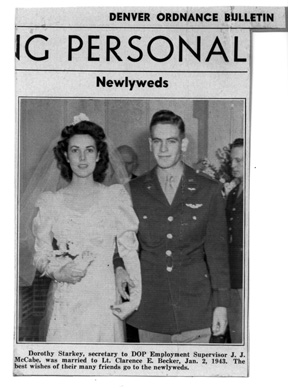 |
|||||||||||||||||||||
| After the F-10 checkout, we entrained back to MacDill via Denver, Chicago and then south. The dining car was removed at Cincinnati. The air conditioning went out shortly thereafter, so we were a hot and tired couple of newlyweds when we arrived in Tampa. After checking into the Hillsboro Hotel, I told Dottie I was going out to find us a place to live. When I returned, with my car which had been at the base, I told her we were moving in with the Woods. Her reply, “Who are the Woods?” Lt Harold Wood and his bride of a couple of years, Marian, had also recently arrived at MacDill. We were fortunate to find a two bedroom two bath house on Tampa Bay for rent. And we moved into the house, named it BeckWood Manor. The house for the next three months became the squadron late night hangout after the Officers Club at MacDill closed. We had plenty of space for dancing, and socializing. Our friendship with the Woods has lasted as long as our marriage. Currently, some 59 plus years. |
|||||||||||||||||||||
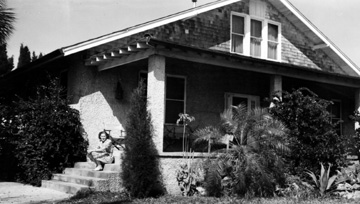 |
|||||||||||||||||||||
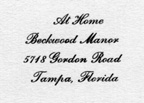 |
|||||||||||||||||||||
Our new F-10s arrived; many new crews formed and checked out and by the end of March we took 3 flights of 4 planes each North. My flight headed for Naknek, Alaska. We stopped at Rome, NY where our planes were equipped with snow tires. Then on to Camp McCoy, WI where we picked all arctic clothing, parkas, muckluks, heavy gloves, etc. Then on to Great Falls, MT, Edmonton, Alberta, Watson Lake, Yukon Territory, Fairbanks, and Anchorage where we checked in with the theater commander before heading out to Naknek on the Alaskan peninsula. The other two flights headed for Fort McMurry, north of Edmonton where a photo lab for the squadron was built. Our mission: to map all of Alaska and Northwest Canada. Our F-10s were equipped with 3 tri-metrogon cameras mounted in the nose giving them a bug nosed appearance. The planes had no armament or insulation. At our mapping altitude of 20,000 feet, it was extremely cold even if we were not in the arctic. The F-10s were a drastic improvement over the F-2s and A-29s we had been flying. We all loved the airplane. |
|||||||||||||||||||||
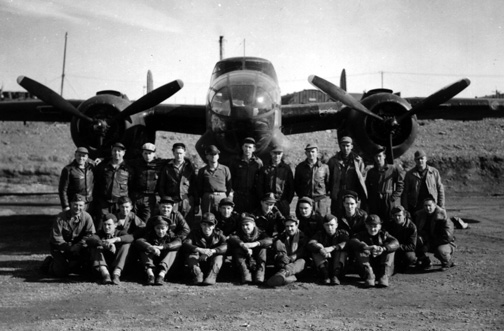 |
|||||||||||||||||||||
|
Alaska, May 1943 |
|||||||||||||||||||||
| Upon our arrival at Naknek, we were weather bound for the first two weeks. Our first priority: to map the Alaskan Peninsula and the entire Aleutian Chain.--too many clouds. The theater commander sent a Lt Col from Anchorage with an order that we were now under his command and would move immediately to Adak and take tactical photography of the Japanese held islands of Attu and Kiska. I accepted the order and told the Lt Col that I would let my boss at Bolling Field, DC know of the action. We moved on out to Adak and for two days flew tac recce at low altitudes over Attu and Kiska. The same Lt Col met me after the second day with a teletype in his hand. He handed me the teletype, said, “Captain, you’re on your own.” |
|||||||||||||||||||||
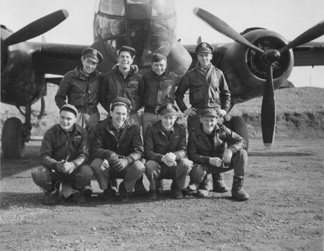 |
|||||||||||||||||||||
|
Top, L to R: 1st. Lt. Bob Hickethier, 1st Lt. Jack bailey, 1st Lt. Murry Schott and Capt. Clarence Becker. Bottom, L to R: 2nd Lt. Bill Hartwell and three unknowns (Additional information from web site visitors will be welcomed.) |
|||||||||||||||||||||
|
The wire was addressed to the theater commander and read, “The 3rd Photo Mapping Squadron is in Alaska on a priority, I repeat, priority mission and will not, I repeat, will not be diverted from its primary mission. Signed, General H. H. Arnold.” I wish that I had kept that wire.
The next morning, the weather cleared completely. We took all 4 planes off, mapped as much as we could landing at Dutch Harbor about noon. Refueled, reloaded cameras and took off again; mapping until late afternoon, landing at Cold Bay. The next day, we lucked out for another CAVU day and mapped the rest of the islands and the peninsula including Kodiak, landing back at Naknek. What a stroke of weather luck plus being in the right place to take advantage of it. We were informed later that planes had been unsuccessful during a 6 month periods the previous year. With the Aleutians under our belt, we went back through Anchorage and Fairbanks to Nome. The day we arrived at Nome, we were greeted by clear weather. I was informed that we had never had good photos of St. Lawrence Island. I refueled and before sundown, had full coverage of the island. Again, a stroke of good fortune. The weather at Nome was treacherous. It could move from clear to zero zero in a matter of minutes. So our four crews mapped as much of western Alaska that we could not map from Fairbanks, where the weather was more predictable and better facilities existed. Nome had a 5,000 foot runway with sharp drop offs at both ends. The Russian pilots that were picking up P-39s and B-25s at Fairbanks flew them to Nome and then on across Siberia to the heart of Russia. They crashed many planes at both ends of that single runway. Their B-25s were equipped with Sperry autopilots. Our F-10s were equipped with a much inferior autopilot. Our crew chiefs were very resourceful and before we left Nome, our 4 planes had Sperrys. Moon light requisitions from the Russian crashed area boneyard. |
|||||||||||||||||||||
| One day while at Nome, I was visited by a Catholic Priest who asked if I would take him up for a ride so that he could chart the ice pack that kept Nome closed as a seaport until the latter part of June each year. We had seen all the ships at Cold Bay in the Aleutians waiting for the route to be safe. I took the Priest out to sea where he charted the ice pack and as a result ships were able to get to Nome two weeks earlier than ever before. When we flew back to Fairbanks, we were joined by the other two flights that had been mapping northwest Canada. Together we finished mapping Alaska. |
|||||||||||||||||||||
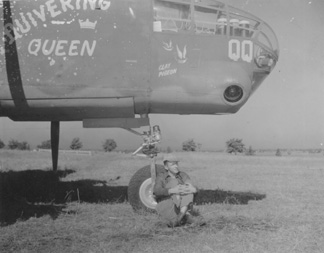 |
|||||||||||||||||||||
|
|
|||||||||||||||||||||
| The hardest area to get acceptable photo coverage was up in the northeast corner of Alaska east of Prudhoe Bay where a thin ice fog persisted . We again were fortunate to be able to get the necessary pictures using infrared film for the first time. Of interest in mid June at Fairbanks was first, the softball games we were able to play up until 11 o’clock at night and second, Fairbanks had the most and fiercest mosquitoes we had ever seen. The mosquitoes swarmed whenever our aircraft were being refueled. The ground crews had to wear head nets and gloves so that no skin was exposed during refueling operations. We finished our mapping assignment about June 15th and headed back to our photo lab base at Fort McMurry, north of Edmonton, Alberta awaiting orders to return to MacDill Field. But that was not to be. We found out later that the Pentagon had expected our mission to take a full year. So, instead of returning to Florida and my bride of less than six months, our squadron was filtered back into the states. My flight was sent to Bradley Field, Windsor Locks, CT, home of the 1st Photo. |
|||||||||||||||||||||
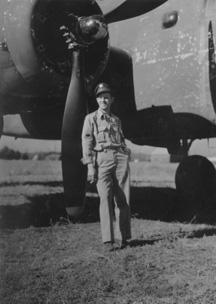 |
|||||||||||||||||||||
|
takes a break using an F-10 prop for a leaning post. |
|||||||||||||||||||||
| One of the other flights was sent to March Field, CA, the other to Felts Field, Spokane, WA. We were at Bradley for about a month. We did photo mapping for the Corps of Engineers in several New England areas while there. I had Dottie come up from Tampa by train. She arrived from New York in Windsor Locks on a coal burner train with no windows. When I picked her up at the station, she looked like a colored person with black soot covering her and the rest of the passengers. We were able to rent a room in the home of a local banker. We had an enjoyable short summer until my flight was ordered to Spokane for an inspection of our aircraft by the 1st Photo Group Inspector General. Dottie went back to Tampa. After the inspection, that found us in great shape, we took all of the F-10s to Hill Field, Ogden, UT where the finger exhaust ring stacks on our engines were replaced with individual short stacks that increased our air speed by about 10 miles per hour. Only after this modification were all 12 of our F-10s and crews allowed to return to our home base at MacDill. |
|||||||||||||||||||||
|
End of Chapter 5 — Go To Chapter 6 1 — 2 — 3 — 4 — 5 — 6 — 7 — 8 — 9 — 10 — 11 Cover Page — Introduction — Table of Contents Or you may go to Home - Contact Us - Cold War Hist. - 91st SRS Hist. - Stardust 40 Mission Story |
|||||||||||||||||||||